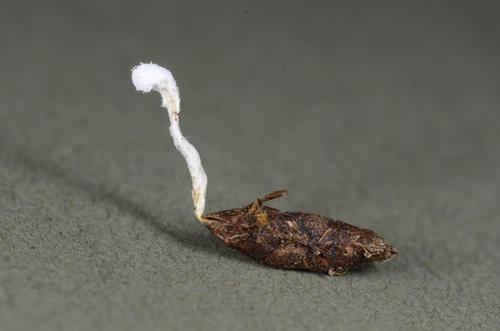Isaria farinosa (Holmsk.) Fr.1832,. Trichomaceae. Found in Wyre Forest, Worcestershire
John Bingham
On 28th January 2012 I found a small white fungus growing in a clump of Polytrichum formosum moss in Hitterhill Wood, Wyre Forest, Worcestershire. The powdery spike was only 20mm long and grew out of the moss, so I carefully dug downwards to find the attachment. When extracted it was found to be attached to a small Lepidopteran larvae, possibly a micro moth of some type (Fig. 1.). Identification of this fungus would have been difficult but thankfully an illustration can be found in the Collins Photographic Guide Book on Fungi (Sterry & Hughes 2009) that clearly indicated it was Isaria (Paecilomyces) farinos.
Isaria farinosa is apparently quite a common fungus as there are some 565 records on the British Mycological Society database (BMS access online). However many records are multiple entries and a search for Worcestershire in the entries only yielded one record, although the ‘dot map’ indicates about six old 10km square records including the Wyre Forest SO77 10×10 km square. This last record I assume is attributable to Carlton Rea as he recorded Isaria farinosa in his fungus list for Wyre Forest (Rea 1923). The only other record I can find for the county was at Ockeridge Wood in 1912. Warwickshire is somewhat better recorded thanks to the 1980 fungus survey by Malcolm Clark et al (Clark 1980), but records were still limited and very scattered. For a supposedly common fungus this is certainly not the case for Worcestershire, although it must be very under recorded! Check your local moss for white powdery fungal spikes, my guess is you will find more.
There are several other common fungi that parasitise insects (Entomopathogenic fungi). Cordyceps militaris with the bright orange club shaped fruit-body being the most commonly recorded species, but Entomophthora muscae sl. (several species) is more frequent and obvious to find as it typically kills Muscid and Syrphid flies, leaving them dead perched on the top of grass stems with grey conidia spores bursting out of the abdomen.
References
Clark, M C. (ed). 1980 A fungus flora of Warkwickshire. British Mycological Society, London.
Sterry, P. & Hughes, B. 2009 Collins Complete Guide to British Mushrooms & Toadstools. Collins, London
Rea, C. 1923. Fungi of the Wyre Forest. Transactions of the Worcestershire Naturalists Club. 1924 pages 16-40.
British Mycological Society. Checklist of the Fungi of the British Isles: http://www.fieldmycology.net/GBCHKLST/gbchklst.asp
Image
Fig. 1. Isaria farinosa growing from a lepidopteran larva. John Bingham
